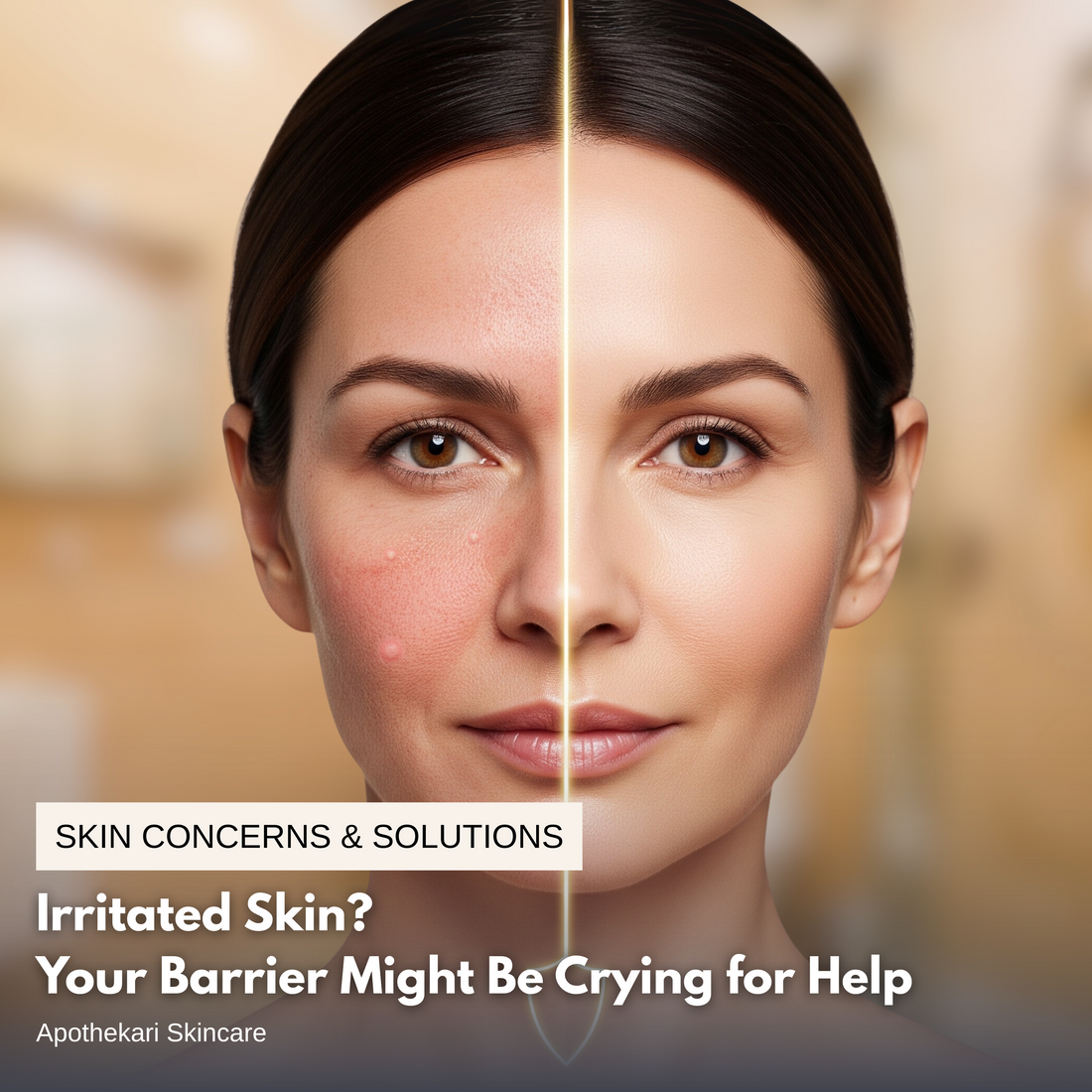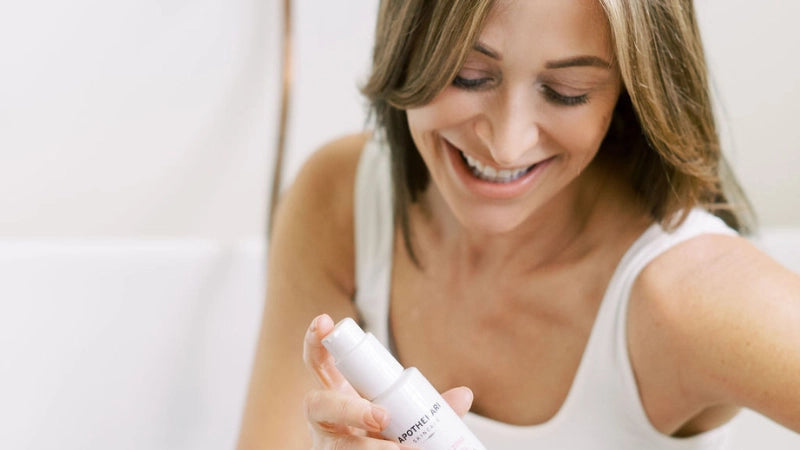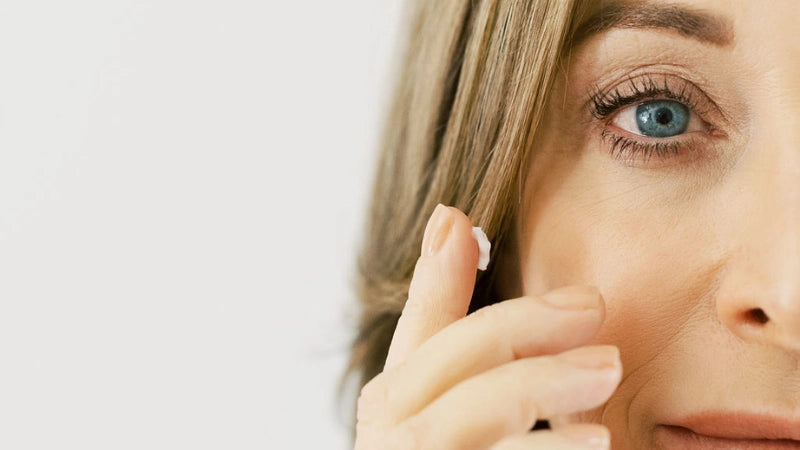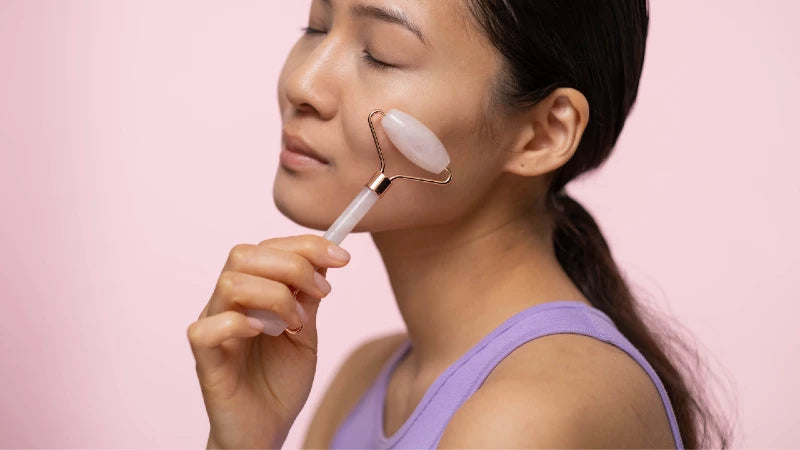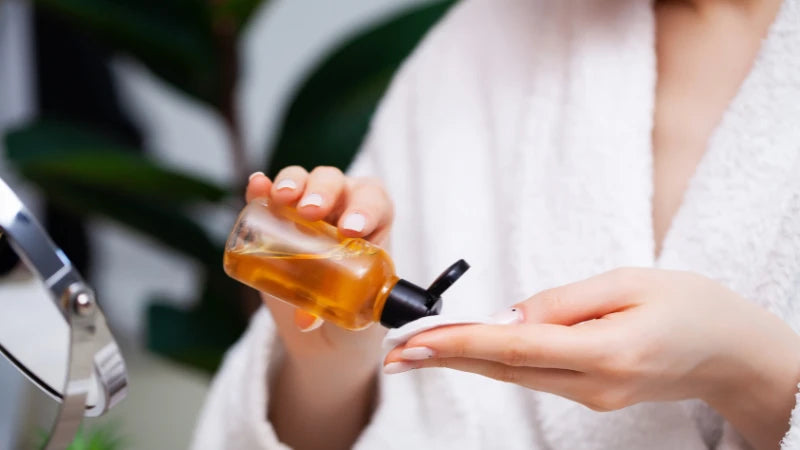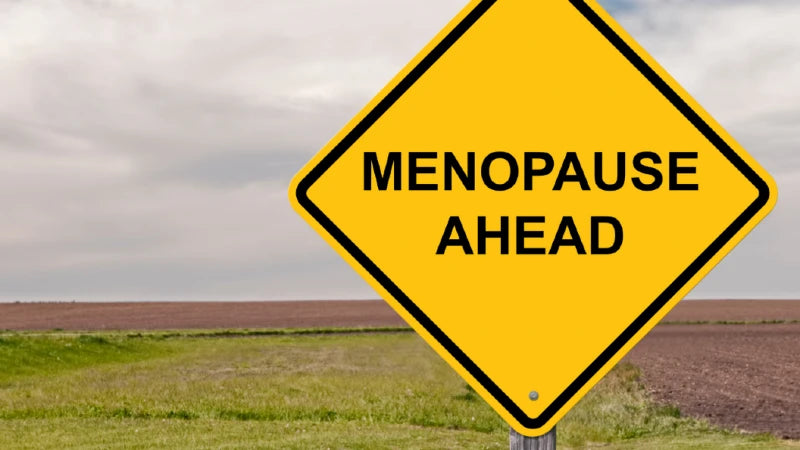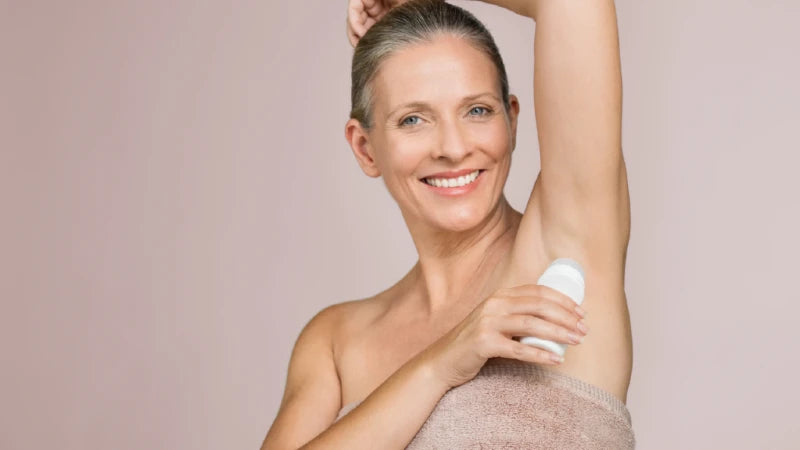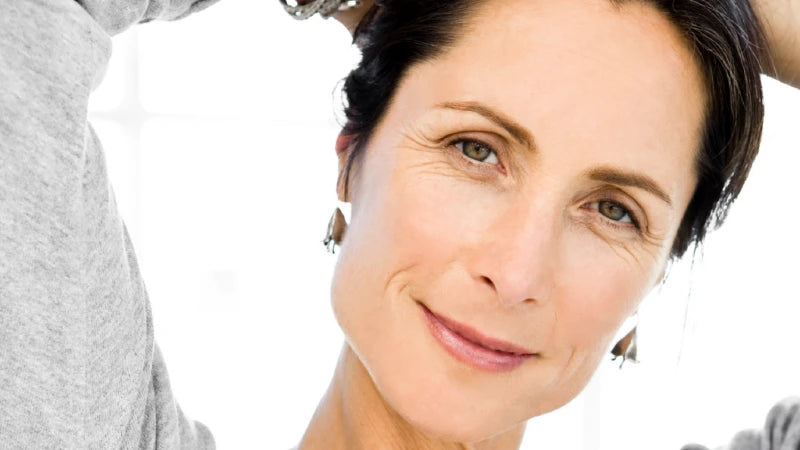Blog
Irritated Skin? Your Barrier Might Be Crying for Help
Skin suddenly acting up? Hormonal shifts can weaken your skin barrier, causing dryness, irritation, and breakouts. The fix: gentle care, deep hydration, and a simple routine to restore your glow.
Learn moreSkincare is Self Care. Make it a Ritual.
Skincare is selfcare? It’s an often cited mantra that we hear these days. Yet in the hustle and bustle of our daily lives, when we’re trying to juggle so many different things, it’s easy to overlook the significance of our skincare routine. Shop All Apothekari But what if I told you that your skincare regimen is more than just a series of steps to maintain healthy skin? It’s also a self-care ritual—an act of kindness you show to yourself daily. Your skin, the body’s largest organ, deserves attention beyond the superficial, and this attention can manifest as a deeply enriching experience. Your skincare routine should be more than a task; it should be something you genuinely enjoy. Consider it an opportunity to engage in a ritual that provides benefits not only to your skin but also to your mind and overall well-being. The importance of establishing routines lies in the sense of predictability they bring. As your skincare routine becomes a consistent part of your day, it transforms into a source of comfort, a predictable retreat in an otherwise chaotic world. Picture this: you’re in your bathroom, perhaps with your favorite calming playlist in the background. The gentle application of skincare products becomes a form of self-love, a few moments dedicated entirely to yourself. It’s an almost meditative experience, a pause in the daily hustle to reconnect with your body and send a powerful message that you matter. Elevate Your Skincare Practice with These Tips Now, let’s infuse some magic into your skincare routine with these tips to turn it into a full-fledged self-care celebration: Set the Mood with Relaxing Music. Transform your skincare space into a personal sanctuary by playing your favorite tunes. Let the soothing sounds create a spa-like ambiance. Meditate Your Way to Glowing Skin. Elevate your routine with a guided meditation app. Combine the benefits of skincare with the tranquility of meditation for a truly holistic experience. Indulge in a Luxurious Bath. Take your self-care routine up a notch by indulging in a long bath, scrubbing away roughness with our Foaming Bamboo Polish, followed by our Shea Body Butter. It’s a sensory delight that locks in moisture and leaves you feeling pampered. Enjoy the Art of Skincare. Embrace the simple steps, like massaging a serum or our Antioxidant Face Oil into your skin. These moments of self-massage not only benefit your skin but are also incredibly relaxing for your mind and body. 7 Science-Backed Self-Care Ideas For You to Embrace I’m not messing around, cause these are seven science-backed self-care ideas that can seamlessly integrate into your daily, weekly, or even hourly schedule. The good news? They’ll not only help you to feel better–and when you feel better, you’ll look better too: Get Outside. Step into nature to reap its meditative benefits while also incorporating some exercise into your routine. Pay it Forward. Spread joy by helping others, whether it’s through giving your time, money, or a heartfelt compliment. The positive energy you share will, in turn, uplift your spirits. Stress Less. While stress is inevitable, find strategies to manage it. Whether it’s a brief tea break or some alone time, these moments contribute to your overall well-being. Be Mindful. Practice being present, steering clear of worries about the past or anxieties about the future. Mindfulness can significantly enhance your mental health. Dance. Burn calories and boost your mood with a spontaneous dance party—perhaps even while prepping dinner. It’s a fun and effective way to stay active. Eat More Fruits and Veggies. Fuel your body with a rainbow of nutrient-rich foods, providing antioxidants, micronutrients, and fiber essential for good health. Get Enough Zzzs. Prioritize sleep, even if it’s just a quick cat nap. Quality sleep is linked to a myriad of health benefits, from improved mood to reduced risk of chronic conditions. Is Skincare a Form of Self-Love? Absolutely! Your skincare routine is a daily affirmation of self-love, a consistent practice that highlights your importance amidst life’s chaos. Why is Skincare Important to Life? Skincare transcends mere aesthetics; it’s a form of self-nurturing that sends a powerful message to your body: you value and care for it. Can Skincare Boost Self-Esteem? Indeed. A thoughtful skincare routine can boost self-esteem by fostering a positive self-image and instilling a sense of self-worth. Is Skincare Part of Your Lifestyle? If it isn’t it absolutely should be! Integrating skincare into your daily routine enhances your lifestyle, creating pockets of self-indulgence and care throughout your day. Benefits of Skincare on Mental Health Beyond its physical effects, skincare has an impact on mental health, offering moments of tranquility and self-reflection. Your skincare ritual becomes a daily dose of mindfulness, contributing to a healthier state of mind. As you embark on this journey of skincare as self-care, remember: it’s not just about looking good; it’s about feeling good, embracing moments of tranquility, and sending a powerful message to yourself that you are worthy of love, care, and radiant skin. Your skincare ritual is your daily celebration of self, a small yet significant act that contributes to your overall well-being. So, let the magic of skincare and self-care unfold each day, making you feel as beautiful on the inside as you look on the outside. Cheers to a healthier, happier you!
Learn moreHow To Look After Your Aging Skin: A Pharmacist's Guide to Skincare After 50
If you’re seeking the inside scoop on aging skin care, step into the laboratory of skincare wisdom. Our founder, Sharmani, a pharmacist and a mature woman herself, expertly blends science with style to unveil the art of aging gracefully. Ready for a journey that’s as scientific as it is fabulous? Shop Active Treatment Serums Is 45 Too Late to Start A Skincare Routine? It’s never too late! Dive into the world of timeless beauty with three main products, the Holy Grail for mature skin: Sunscreen Vitamin C (like the triple combination of vitamin C and antioxidants found in our Glow Getter3 Serum) Retinoids, like the powerful, yet gentle retinaldehyde combined with other highly active ingredients in our Advanced+ Renewal Serum. These three products should form the foundation for your aging skin care regimen. What Should My Skincare Routine Be at 50? Whether you started earlier or are just embarking on your serious skincare journey at 50, there’s no wrong time to craft a precise skincare routine. The same principles apply to 50-something skin as it does in your 40s: sunscreen, vitamin C, and retinoids. And because 50-something skin can start to experience dryness, make sure you have a good moisturizer like our Daily Infusion+ on hand. This hydrating powerhouse keeps your skin’s balance in check. How Can I Make My Aging Skin Look Better? To minimize the appearance of wrinkles and fine lines and leave your skin looking radiant and glowing, elevate your skincare routine with our Radiant Skin Set, which combines a morning and nighttime serum (Glow Getter3 and Advanced+ Renewal) for radiant and youthful-looking mature skin. Make sure to use something to combat dryness, which can age skin. Should You Use Retinol in Your 50s? Absolutely, let science lead the way! Retinoids are backed by oodles of evidence to show that they stimulate collagen production, bidding farewell to fine lines and wrinkles. They also increase skin cell turnover, fight hyperpigmentation, and even increase your skin’s moisture content, helping to combat dryness. Think of retinoids as your skin’s secret weapon, deployed under the cover of night. (retinoids should be applied at night because they are sensitive to sunlight and prone to degradation when exposed to UV rays.) We’re huge fans of the benefits that come with retinaldehyde, found in our Advanced+ Renewal Serum. What is the Best Skin Care Routine for Women Over 50? For actual results (not overhyped nonsense), get started with our Ageless Skin Set. In addition to our two serums, Glow Getter3 and Advanced+ Renewal, we include our hydrating Daily Infusion+ Moisturizer and Amazing Clean, an exfoliating cleanser (but caution sensitive skin with this one!) It contains the essentials for better looking skin–just add sunscreen. What is a Good Skin Care Routine for Aging Skin? Crafting a good skincare routine for mature skin isn’t as difficult or as confusing as you may imagine. Start with cleansing, which helps remove dirt and make-up and provides a clean canvas to help absorb other products. Next, prevent damage and protect skin with antioxidants and sunscreen. Finally, add in a retinoid treatment to rejuvenate and perfect skin. Nourishing face oils like our Antioxidant Face Oil and performance moisturizers like our Daily Infusion+ Moisturizer help keep mature skin protected against dryness, which can emphasize the appearance of wrinkles and fine lines. What is the Best Treatment for Aging Skin? The ultimate treatment for mature skin? It’s about finding the right products that work for YOUR skin and using them consistently. Beautiful skin doesn’t happen overnight or by chance. It’s a combination of a number of factors, including your lifestyle, your genetics and the skincare products you use. Eat well, exercise, get enough sleep, manage stress. Then add in scientifically proven ingredients and use them consistently in your skincare routine. Find products and a program that works for you and stick with it. It can take weeks to months to notice a difference. But stay with it, and you’ll reap the benefits. Dos and Don’ts For Skincare After 50 Now, let’s dive into the two most important Dos and Don’ts for skincare after 50. ✅ Do embrace a consistent routine tailored to your skin’s needs. ❌ Don’t skip sunscreen; it’s your best defense against premature aging. Should You Use Anti-Aging Products? Let’s challenge the term “anti-aging.” At Apothekari, we believe in embracing the beauty of getting older. Anti-aging suggests a fight against the natural process of aging, while we encourage a celebration of the journey and caring for your skin gracefully. We’ve long dropped this term from our marketing and we think it’s high time that everyone else does too! How to Care for Oily Mature Skin If you’re dealing with oily aging skin, embrace balance. Cleanse with our Amazing Clean, designed for exfoliation without irritating. Use lightweight moisturizers like our Daily Infusion+ to hydrate without causing excess oil. Retinoids like the retinaldehyde found in our Advanced+ Renewal Serum have been shown to minimize the appearance of blemishes and breakouts due to their impact on managing oil production and antibacterial effects. If you find yourself starting to breakout like you did in your teens, Advanced+ Renewal may just save the day! How Can I Make My Aging Skin Look Better? We really don’t think there’s a better place to start seeing a transformation in your mature skin than by elevating your routine with our Radiant Skin Set. This duo of serums (Glow Getter3 and Advanced+ Renewal) works in harmony for radiant, youthful-looking skin. As you gracefully move through your 60s and 70s, continue with the same Apothekari products that are working for you. There’s no need to change things up because your skin doesn’t become immune to the effects of a good skin care product. If you notice that your skin becomes drier or more sensitive, look for moisturizers that deliver heavy-duty results. Or consider adding in a face oil. You may also notice dryness in areas besides your face. It’s one of the reasons that we developed More Than Lip Service. This vulvar and vaginal moisturizer delivers fast, long-lasting, and hormone-free relief from the pain, burning, and irritation that many women experience down there as they get older. Explore how our range adapts to the evolving needs of your skin, ensuring a radiant and healthy complexion. Here’s to timeless elegance, no matter your age.
Learn moreDry January: Are You Missing Out?
Welcome to that time of the year when wine glasses take a back seat, and water bottles step into the spotlight. For me, it’s the seventh spin on the Dry January train—a tradition that started with a classic hub-side eye-roll, questioning my sanity. Little did he know; he secretly looks forward to it every year. Or maybe he’s just a really good actor! What’s the Buzz with Dry January? So, why Dry January, you ask? Well, it’s my post-holiday ‘cleanse’—and I use the term loosely. After a month of indulging in festive foods and perhaps a tad too much wine, January becomes my month of redemption. Out go the cheese, wine and shortbread cookies; in come veggies and water. It’s all in an attempt to squeeze into my favorite jeans without having to go up a size. Because, let’s face it, my wardrobe and I are inseparable BFFs, and I’m not about to betray it. (and yes, there’s the undeniable benefit of just feeling better nourishing my body with healthier options) The Dry January Elevator Pitch Abstaining from alcohol is the easy part. Explaining it? Now, that’s the real challenge. “No, I’m not pregnant. It’s just a miracle I’m still standing at my age!” It took a while, but I’ve perfected my Dry January elevator pitch over the years. What is the Point of Dry January? Dry January isn’t just about swapping out alcoholic beverages for non-alcoholic delights. For me, it’s a personal reset button, a chance to recalibrate after the holiday frenzy. It’s an opportunity to focus on nourishing my body with veggies and hydrating with water, all while giving my skin the love it deserves. Why Do They Call it Dry January? The name might sound straightforward, but the origins of Dry January are rooted in mindfulness. It started in the UK as a movement to encourage people to be more conscious of their alcohol consumption after the indulgent holiday season. The trend has since spread globally, with many embracing the challenge as a way to kickstart a healthier year. What are the Rules for Dry January? The rules are simple: no alcohol for the entire month of January. It’s a commitment to sobriety for 31 days, allowing your body to reset. It’s not about perfection but about the intention to break the habit of regular alcohol consumption. (and goodness knows, we’ve read enough articles lately about the negative impact of excessive alcohol consumption on our wellbeing). Dry January Benefits Aside from the obvious health benefits like improved liver function and better sleep, Dry January can do wonders for your skin. Alcohol can dehydrate the skin, leading to dullness and premature aging. Dry January Skin Benefits Beyond the general health perks, the impact on your skin can be quite noticeable. One of the key benefits is the restoration of skin hydration. Alcohol is very dehydrating and as a result, notorious for drying out the skin. This often causes dullness and the acceleration of premature aging. By abstaining from alcohol, you’re allowing your skin to reclaim its moisture, leading to a radiant and healthier complexion. What are the Disadvantages of Dry January? While the advantages outweigh the disadvantages, some may find social situations challenging without the usual social lubricant. However, navigating these situations sober can lead to personal growth, increased confidence, and a deeper connection with others. You’ll never know unless you try it! My Dry January Sippers Just because I’ve gone alcohol free, it doesn’t mean I don’t want something special to sip on. Thankfully, we’re pretty spoiled for choice when it comes to prepared mocktails, zero proof beers and even some wine–but there’s still a way to go in that department. Besides the standard bubbly water and Coke Zero in our fridge, I’m currently savoring Sober Carpenter’s incredible IPA. I’ve also delved into the world of Clever Mocktails—a collection of delectable, not overly sweet concoctions. (Check out their G and T or Mojito). Unfortunately–and sadly–because I love red wine, I think they still have a way to go before one will pierce my Dry January heart. I have had luck with some sparkling wines made by Noughty and Oddbird have left a pleasant impression. I think sparkling is definitely the way to go here! And, of course, my inner mixologist makes an appearance in my spare time—blame it on the pharmacist in me! For the behind-the-scenes magic, check out my Instagram where I will be sharing any concoctions I come up with. And, check out our last post, where I shared the recipes for 3 mocktails that you may want to try making yourself. Now I know that Dry January isn’t for everyone. And if that’s the case, there’s no judgement here—you do you! But, if you decide to participate, you may be pleasantly surprised by how you feel after a month without alcohol. Got any stories to share? We’re all ears!
Learn moreDon't Put Up With Vaginal Dryness! This is How to Treat it
Vulvar and vaginal dryness are a common, yet ‘silent’ problem because many women feel embarrassed to talk about it with their partners, friends and even doctors. It can have a really negative impact on quality of life, yet only 25% of women seek help to manage their symptoms. Shop Intimate Care Feminine Moisturizer What is a Natural Remedy for Dry Down There? We’re here to change that and that’s why we’re so excited to share news about More Than Lip Service. You moisturize the rest of your body so why not your vulva and vagina? Our moisturizer helps to treat the symptoms associated with vulvar & vaginal dryness, allowing you to embrace life again. Made with a combination of hyaluronic acid (which your body produces naturally) plus vitamin E and other beneficial ingredients, More Than Lip Service gives you fast, long-lasting & hormone-free relief from the burning, itching & pain associated with vaginal atrophy, vulvar and vaginal dryness. Unlike those other lubricants that just slip right out, ours not only immediately alleviates dryness symptoms but also lasts so long, you may not even need to use it every day. Why Am I Dry Down There All of a Sudden? Over half of women aged between 51 and 60 experience vulvar & vaginal dryness, leading to pain, irritation and burning. While it’s more common in older women, younger women aren’t immune. Around 17% of women aged 18-50 experience issues, even before menopause. The hormonal changes associated with aging—in general, a decline in estrogen levels—is the main cause, but feminine sprays and harsh soaps, swimming pool & hot tub chemicals, detergents, and some medications can also lead to vaginal dryness. It may also be problematic during sexual intercourse, resulting in pain along with intimacy issues. What Causes Vaginal Dryness? A normal, healthy vagina: Is kept supple and moist with natural lubrication produced by glands at the neck of the womb (the cervix). This moisture makes its way slowly down through the vagina, keeping it clean and removing dead cells. The moisture is slightly acidic, helping to keep the area, including the vulva and the labia healthy, preventing infections like thrush. Most women may notice a slight white vaginal discharge – this is perfectly normal. The Bartholin’s glands (two glands at the entrance of the vagina) produce extra moisture to aid sexual intercourse when a woman is aroused. However, a quarter of women aged 50-59 experience vaginal dryness problems during sex and 16% experience pain. In addition to the natural lubrication that makes its way down through the vagina, there’s also a thin layer of moisture that coats the walls of the vagina. This moisture helps sperm travel and survive in for sexual reproduction. It also helps to reduce friction during sexual intercourse. As a woman gets older, a decline in estrogen production can cause the vaginal walls to thin, resulting in fewer cells that secrete moisture. Apart from age, vulvar and/or vaginal dryness may be associated with: Breastfeeding Cigarette smoking Depression Excessive stress Immune system disorders, such as Sjögren syndrome Childbirth Rigorous exercise Some cancer treatments, such as radiation to the pelvis, hormone therapy, or chemotherapy Surgical removal of the ovaries Some medications, including douching, as well as some creams and lotions that are applied to the vaginal area. Can Dehydration Cause Dryness Down There? If you’re not drinking enough water, then your skin—anywhere on your body—is prone to dryness. Dehydration can take a on your vaginal health, leaving the skin feeling itchy and dry. It can also throw off the pH balance, possibly contributing to conditions including yeast infections. Make sure that you’re drinking enough water (most experts recommend somewhere between 6-10, 8 oz glasses a day. Tea, coffee, fruits and vegetables all count towards this and you may need more depending on your level of activity and personal needs. What are the Symptoms of Vaginal Dryness? How Long Does Vaginal Dryness Last? Vulvar & vaginal dryness cause discomfort in the vaginal and pelvic regions along including: Burning Loss of interest in sex Painful sexual intercourse Light bleeding following intercourse Soreness Urinary tract infections (UTIs) that don’t go away or that reoccur Vaginal itching or stinging Beyond painful intercourse, untreated vaginal dryness can cause sores or cracking in the vagina’s tissues. See your doctor if you experience the following: Vaginal dryness that lasts for more than a few weeks and and that isn’t fixable with over the counter solutions (see below) Vaginal dryness is affecting your daily life You experience unusual discharge or bleeding from your vagina You have bleeding after sex or in between your periods If severe vaginal bleeding occurs, it’s important to seek immediate medical attention. How Do You Get Rid of Dryness Down There? Although it can throw havoc with your day to day activities, vulvar & vaginal dryness aren’t life threatening. Thankfully, treatments are available. 1. What is the best lube for menopause? Similar to natural lubrication, lubricants provide temporary relief from dryness and discomfort. Lubricants may be used at any time and aren’t just reserved for perimenopause or menopause. They should be applied to the area around the vulva (lips) and vagina just before sexual intercourse. 2. What is good for vaginal dryness? (Hint: Moisturizers!) Longer lasting than lubricants, moisturizers like More Than Lip Service are designed to be used two to three times a week. They may be used externally or used internally and their effect lasts for days. They’re a great option for women who can’t—or don’t want to—use hormonal options. 3. Do estrogen pills help with dryness? Estrogen pills are a hormonal option available by prescription to help manage vaginal dryness. Creams, gels, patches and rings are also available to give you a range of products to choose from. Supplementing with estrogen can help to manage a range of perimenopausal and menopausal symptoms that women may encounter, including not only, vaginal dryness, but also hot flashes and brain fog. If you feel that you’d benefit from going this route, check in with your physician who’ll be able to help you navigate the choices to find one that works for you. If your main concern though, is vaginal dryness, studies have shown that vaginal moisturizers made with hyaluronic acid and vitamin E (like More Than Lip Service) are comparable in efficacy to hormonal treatments and without the risk of side effects. (1,2,3) Check with your health care provider if you aren’t sure about your options. (1) Jokar A, Davari T, Asadi N, Ahmadi F, Foruhari S. Comparison of the Hyaluronic Acid Vaginal Cream and Conjugated Estrogen Used in Treatment of Vaginal Atrophy of Menopause Women: A Randomized Controlled Clinical Trial. Int J Community Based Nurs Midwifery. 2016 Jan;4(1):69-78. PMID: 26793732; PMCID: PMC4709811. (2) Stute, Petra. Is vaginal hyaluronic acid as effective as vaginal estriol for vaginal dryness relief? Multicenter Study Arch Gynecol Obstet . 2013 Dec;288(6):1199-201. (3) Chen J, Geng L, Song X, Li H, Giordan N, Liao Q. Evaluation of the efficacy and safety of hyaluronic acid vaginal gel to ease vaginal dryness: a multicenter, randomized, controlled, open-label, parallel-group, clinical trial. J Sex Med. 2013 Jun;10(6):1575-84. doi: 10.1111/jsm.12125. Epub 2013 Apr 9. PMID: 23574713.
Learn more11 Overrated Skincare Products (That You Probably Don't Need)
Just because a cute 20-something is pushing it on social media, it doesn’t mean you need it, or that it’s even good for your skin—here are 11 overrated skincare products that your skin (and your wallet) can do without. SHOP RADIANT SKIN SET Overrated Skincare Products. What Skincare Products Are Necessary? Hype isn’t something that we DON’T do at Apothekari – our line of no fluff, more active ‘stuff’ treatments will transform your skin and provide relief from your skin’s changing needs. Do We Really Need All These Skincare Products? Here are some on the ‘to ditch’ list. 1. At-Home Microneedling Kits Studies have shown microneedling to be beneficial in helping with the absorption of topical skincare treatments like vitamin C and retinoids—when done in a professional setting. At home kits have issues around hygiene and safety. AND, the needling device is likely to be very shallow—so shallow that it won’t be effective. 2. Activated Charcoal Treatments From cleansers, to soaps and shampoos (and underarm detoxes too), charcoal containing products are big sellers these days. While they claim to ‘detox’ and remove dirt and oil, they can only do this on the skin’s surface so the effect is unlikely to be significant. Overrated skincare product for sure – especially don’t buy into charcoal detoxes for your armpits. They are totally unnecessary when making the switch to a natural deodorant like ours. 3. Cellulite Cream They’re usually pricey. More importantly, they do not work. Cellulite creams work no better than a good moisturizer. And, research has shown that physical massage and exercise can help to improve the appearance of cellulite more than any cream can. Keep in mind that cellulite is part of the normal aging process and every woman gets it. It’s impossible to shift it with topical treatments. Does Some Skincare Make Your Skin Worse? Some skincare products and ingredients can actually be harmful to skin, especially if not used correctly. For example: 4. Essential Oils Some essential oils have some great properties—and they smell amazing (love them in my diffuser). But, applied full strength to the face, they can lead to dermatitis, skin irritation, rosacea or psoriasis. While it can be safe to use essential oils on the face, they must be diluted in a carrier oil first. What is unnecessary in skin care routine? Although lots of people use these products, there’s often no need. Here are more overrated skin care products that you can say bye-bye to. 5. Toners We’re not alone in our distaste for useless skincare products and toners fit the bill. Unless they are formulated with ingredients that have a specific function—to hydrate, or minimize acne—they don’t need to take up space on your counter. 6. Stretch Mark Treatments Much like cellulite creams, stretch mark products can’t penetrate deep enough to treat the scarring in the dermis layer of the skin. We’re ranking this up there for worst skincare products. Try a good moisturizer instead. 7. CBD Skin Care Is this not the hottest trend right now? While there’s some research to show that CBD helps with skin inflammation, much more is needed before we can determine whether it fits into the category of overrated skincare products, or ones that actually deliver as promised. These Skin Care Trends Need to Go Away Popular on TikTok and other social media channels, there are some trends that look like a lot of fun—and promise tons of unproven benefits. Now we’re not saying not to do these because for the most part, they’re harmless. But…don’t expect much benefit. Studies have shown that these just don’t work. 8. Face Rollers Is everyone using (or selling) a facial roller these days? They may feel soothing—especially when chilled—but there’s very little science to support the anti-aging claims associated with these overrated skincare products. Made of jade? Or rose quartz? Or amethyst? Doesn’t matter. While they’ll help to reduce swelling or puffiness for the short term, they’re not going to deliver any long term benefits. However, if you enjoy using them, there’s no harm. Just don’t expect the marketing miracles. 9. Face Yoga Face yoga, or even face exercises promises to help lift and firm your skin. Sounds tempting, right? Sadly, there’s very little evidence to suggest that it works. Here’s why. Our face is made up of skin, fat and muscle layered on top of the skull. Beneath the subcutaneous fat are fat pads, which are plump, fat-containing areas that fit together like a jigsaw puzzle to create the volume that gives our face shape. It’s these fat pads that play a role in the fullness of your face; the fuller your face, generally speaking, the younger you look. As we get older, the fat pads begin to thin and become less plump … and as they do this, they also sag. That sagging can leave the face looking hollow as we age. Facial exercises can’t increase the plumpness of the fat pads or make them sag less. They also don’t change the look or feel of the skin itself. No matter how many exercises you do, the muscles under the fat pads won’t help to make your face look fuller. And when it comes to wrinkles and fine lines, there’s no real impact on the support structures (collagen and elastin) in the skin that over time break down and lead to the signs of aging. The good news? Face exercises aren’t harmful, but they’re not a replacement for a consistent skin care routine, including cleansing, sun protection, retinoids, antioxidants and moisturizing. Procedures like fillers, Botox or surgery are far more effective than face exercises if you’re looking for more dramatic results. Check in with your dermatologist if it’s something you’re considering. Do them if they make you feel good, but just don’t expect your skin to look any different. 10. Bee Sting Facials Some studies have shown that bee stings can reduce inflammation. There is the sticky problem though, of bee sting allergies, which can be deadly in susceptible individuals. I think we can safely say that the risks outweigh the benefits for this DANGEROUS and overhyped skincare trend. 11. Snail Mucin A popular K-beauty ingredient, snail mucin comes from snails. It’s reported to have a high concentration of hyaluronic acid, which we know has many skin benefits. But, does it really need to be harvested from a snail when safe and effective options are already available, like the hyaluronic acid—and its relative, sodium hyaluronate—found in our Glow Getter Serum, Daily Infusion Moisturizer and More Than Lip Service Vulvar & Vaginal Moisturizer. What Skincare Products Are Really Necessary? I’ve called out 11 overrated skincare products that are likely going to suck up your time and not give you the results you’re looking for. If you can ignore those 11, which ones are essential to having healthy, glowing skin? Here’s a few things to consider: Know Your Skin Type The key to finding the right products is to identify your skin type – is it dry, oily, normal, combination? What are your concerns? Fine lines, wrinkles, dryness, acne, age spots? Understanding what your skin needs will help you to identify the ingredients and products that are the best fit. Be Consistent Like taking your medicines as instructed, a consistent skin care routine is key to getting results from your skincare products. You need to allow at least 4 to 6 weeks for topical treatments to notice a difference because it takes that long for your skin cells to turn over (renew). Along with regular use, don’t keep adding or eliminating products (unless you experience a reaction) because you’ll never get a grasp on what’s working for you. Be Gentle Too many stripping cleansers or exfoliating too often, can disrupt your skin’s protective barrier, leaving it prone to infection and irritation. Be mindful of the products you’re using. What Are the Only 3 Skincare Products You Need? If I had to choose just 3 skincare products, I know exactly which ones I’d choose: Sunscreen. And I’d use it Every SINGLE DAY. The sun’s UV rays are responsible for more than 80% of skin aging. Find a good broad spectrum sunscreen with a minimum SPF 30 and apply it in the morning. Retinoid. Retinoids like retinaldehyde in our Advanced+ Renewal Serum are one of the best ways to boost the production of collagen and elastin, which form part of our skin’s supporting network. These two proteins decline as we age, leading to fine lines, wrinkles and skin sag so it’s the most effective way to fight back against the most visible signs of aging. There are many other retinoids to choose from so find one that works for your skin to reap its benefits. Antioxidant. Antioxidants like the vitamin C in our Glow Getter Serum help to protect skin against free radicals—unstable molecules that we encounter as a result of sun and pollution exposure—that can lead to skin damage. Of course, life isn’t that simple so most of us need to rely on a few additional products as well. I’d say that a good cleanser—one that helps to remove dirt and make-up without stripping skin is also key. And finally, a moisturizer is something that most women need, especially as they get older and skin becomes drier. Need help choosing a moisturizer? Check out this post: 5 Questions to Ask Before You Choose a Moisturizer. Got anymore overrated skincare products to share? Let us know your worst skincare picks!
Learn moreDo You Need a Face Toner?
The face toner has been around for a long, long time. Once, it was deemed an essential component of a good skin care routine. But is it necessary today? Shop All Apothekari What is Face Toner and How Do You Use It? Face toner is a liquid skincare product that can play lots of different roles in your skincare routine depending on the ingredients that they contain. They’re often promoted as a way to remove ‘impurities’ or residual dirt that may be left behind on your face after cleansing. But, if you’re cleansing properly, and removing make-up first. Or, if you’re double cleansing, this step of toning seems a bit redundant. What Does a Toner Do for Your Face? In addition to removing left behind dirt, toners claim to hydrate, prime or sooth skin. As well, they are promoted to help your moisturizer absorb fully. And then, there are toners filled with additional active ingredients—salicylic acid for example—that may be used as treatments for some skin conditions, like acne. Is Face Toner Necessary? Without coming across as wishy washy, the best answer is that it depends. Toners have traditionally been applied after cleansing for two reasons mainly: Getting rid of dirt that remains post washing, as mentioned above To pH balance the skin. However, most cleansers—and skincare products in general—are pH balanced today, making this step unnecessary. Older face toners often contained high concentrations of alcohol and had an astringent effect— drawing water out of your skin’s tissues—helping to minimize the appearance of your pore size and reducing sebum levels. But they were often very harsh for dry or sensitive skin types. Today, toners tend to be water-based products and made with a variety of ingredients that can help to hydrate, protect, soothe, brighten, remove excess oil or reduce breakouts. Ingredients may include: Glycerin to moisturize Hyaluronic acid to increase hydration Antioxidants to protect Bisabolol to calm Alpha and beta hydroxy acids to exfoliate and reduce blemishes Retinoids to boost collagen What Happens if You Don’t Use Toner? The short answer is, very little. If you’re following a consistent skin care regimen made up of products that work for your skin and that deliver results, then a toner is redundant as the other treatments will contain ingredients to make up for the absence of toner. When Should I Use Toner? As mentioned above, there’s no burning reason to apply toner. However, if it’s a product that you love; it isn’t duplicating ingredients in your serum, moisturizer, etc, or is a formulation designed to address a specific skin concern, then go at it! Do Dermatologists Recommend Toner? Most skin care professionals, including dermatologists agree that you can skip the toner. Unless, of course, it contains ingredients that specifically proven to help improve a skin condition. Acids for managing acne and blemishes, and hydrating ingredients for soothing dry skin are the most common beneficial uses for toners. Regardless of which toner you choose to use, avoid those that are highly alcohol-based as they are too drying, even if you have an oily complexion. Can I Skip Toner and Use Moisturizer? A resounding yes. As we’ve discussed in this post, toner is an optional skincare product that for the most part, has been replaced by others like serums and even your daily moisturizer. Moisturizers today often contain a combination of effective ingredients including: Humectants, which attract moisture to your skin Emollients (generally oils), which soften and smooth skin Occlusives, which help to protect your skin’s natural barrier system by preventing moisture loss and keeping it safe from harmful external irritants. If you’re using a ‘moisturizing’ toner, a good moisturizing cream and lotion can generally replace it. Can I Skip Toner and Use Serum? Another yes. Serums are widely available and come in a range of formulations with a variety of ingredients to help address most skin care concerns. The great thing about serums is that they tend to be lightweight, making them suitable for all skin types and ideal for layering under (or over) other treatments. Plus, they often contain more than just one ingredient, making them a more efficient—and cost effective—way to deliver skin benefits. So the next time, you ask yourself “Do I need a face toner?” consider that while they aren’t essential in your skin care routine, that they can make for a good supporting act. If you’re into that kind of thing.
Learn moreHow To Fix Menopause Dryness With These Proven Solutions
The bad news—menopause dryness is an inevitable change for women as they age. The main reason for this is due to a drop in hormone levels, primarily estrogen, which leads to some noticeable changes to your skin and hair. The good news? Menopause dryness in all your body’s places is manageable and we’ve got you covered. Read on for all the ways to help turn your skin around. More Than Lip Service is a vaginal and vulvar moisturizer that alleviates the symptoms of dryness down there that occurs in more than 50% of women. Shop Intimate Care Feminine Moisturizer Does Menopause Dryness Go Away? Sadly, the hormonal changes that occur at menopause are permanent. During the lead-up to menopause—perimenopause—and at menopause, your body makes less estrogen, the hormone responsible for maintaining the elasticity, thickness, and suppleness of your skin. And while you may notice drier skin and hair, less obvious places on your whole body, including your neck, back, and chest, to elbows, legs, genitals — even nails, may be affected too. The inside of your mouth, nose, and eyes get drier as you age, as well. You might not think of them as skin, but just like the tissues inside your genitals–they’re called “mucosa,”–hormonal changes impact these as well, leaving you with itchy eye pain, cotton mouth, and that awful sandy feeling in your vagina. Thankfully there are many ways to help you, and your skin, feel better again. What Helps with Dry Skin During Menopause We’ve written about treating dry skin before and many of the tips outlined in these posts and our free guide, can help: Here’s How to Treat Dry Skin as You Get Older Make This One Change to Relieve Dry Skin Make This One Change to Relieve Dry Skin 5 Tips to Help You Care for Your Menopause Skin And you can also download our free guide packed with 7 Powerful—and easy—Tips to Help Banish Dry Skin. Why Am I Dry Down There All of a Sudden? Beyond your skin, hair and nails, you may notice menopause dryness in some unexpected places. Like down there. Estrogen’s impact on your skin also extends to the mucosal tissue found in your vulva and vagina. Low levels of the hormone can lead to thinning, drying, and inflammation of the vaginal walls. Vaginal tissues become more easily irritated. This condition is called vaginal atrophy and can result in: Itching or stinging Burning and pain during sex or urination Light bleeding following intercourse An increased risk for developing urinary tract problems such as urinary tract infections (UTIs) and frequent urination. There are other causes of vaginal dryness as well, including breastfeeding, some medications, and certain medical conditions. Read more about this here: Don’t Put Up With Vaginal Dryness | How to Treat it How do I Treat Vaginal Dryness? Without treatment, vaginal dryness usually worsens over time. And since treatments are available, it’s important to try them to help relieve your symptoms and discomfort. There are 3 main ways to address vaginal dryness: Lubricants Vaginal/Vulvar Moisturizers Hormone Treatments What works for you depends on a number of factors, including personal choice along with trying different products. Many women may start off by using a lubricant but then move to a moisturizer like More Than Lip Service for longer term relief. Hormonal treatments are an option for some women and a discussion with your trusted medical provider is always a good place to start. Can I Use Lube to Moisturize Menopause Dryness? Lubricants are designed to deliver added moisture to your vagina just before sex or pleasuring, but their results are only temporary. Moisturizers on the other hand, deliver longer lasting benefits, keeping your vagina and/or vulva moist all day. Although they work differently and provide different results, you can use lubricants along with moisturizers if that’s what works for you. Vaginal moisturizers like More Than Lip Service are one of the best ways to reduce vaginal and vulvar dryness for the delicate tissue in this part of your body. You can use it daily to begin with, then every few days to help keep the skin and tissues moist and to relieve vaginal dryness symptoms. The moisturizer can also be applied to the vulva to relieve dryness there. Apply before bed to help it maintain contact with tissues. Don’t use moisturizers not meant specifically for this part of your body. What is the Best Vaginal Moisturizer? More Than Lip Service Vulvar and Vaginal Moisturizer offers fast, hormone-relief for when you experience dryness down there. While there are many options to choose from, research has shown that a formulation made with hyaluronic acid (as found in our More Than Lip Service Vaginal Moisturizer), helps to relieve the symptoms of vaginal atrophy, reducing dryness and itching and improving urinary incontinence, comparable to treatment with estrogen therapy. The bonus? It comes without the potential for side effects using hormonal drugs. Int J Community Based Nurs Midwifery. 2016 Jan; 4(1): 69–78. Comparison of the Hyaluronic Acid Vaginal Cream and Conjugated Estrogen Used in Treatment of Vaginal Atrophy of Menopause Women: A Randomized Controlled Clinical Trial Azam Jokar, MS,1 Tayebe Davari, MS,2 Nasrin Asadi, MD,3 Fateme Ahmadi, MD,4 and Sedighe Foruhari, MS1 Vaginal moisturizers are also available in creams, suppositories and natural oils. The key is to find one that works for you. Menopause Dryness Natural Remedies Do a search on the internet and you’ll probably find several safe and effective ways to help alleviate menopause dryness. Use caution with where you’re finding the information as not everyone who gives advice is actually qualified to give this advice. Please always consult your doctor before trying out potentially harmful treatments. That said, there are number of things you can do to help manage dryness naturally: Diet. A diet high in essential fatty acids, found in foods like fish and nuts may help to improve vaginal elasticity and tissue strength. As well, soy contains plant estrogens, which may help to reduce vaginal dryness. Last, drink plenty of water to stay hydrated. Limit caffeine and alcohol, which are dehydrating. Exercise. May help to improve blood flow and balance hormone levels. Caution with Personal Care Products. Douches, scented soaps and harsh cleansers may irritate the area and increase dryness. Have More Sex. Studies have shown that sexual intercourse helps to increase blood flow to your vagina, helping to keep tissues health. Remember to use a lubricant to help eliminate dryness and make sex more pleasurable.
Learn moreHow To Look After Summer Skin | 7 of the Best Tips
We’re sharing 7 of the best tips to help you keep your summer skin looking radiant and beautiful this season and beyond. If you love the summertime as much I do, this is a must read! Shop All Apothekari How Can I Care For My Skin in the Summer? 1. First, Put on Your Sunscreen Remember when you were 10 and your mom sent you outside to play with your friends during summer break? ALL DAY LONG (you could only come in to pee and if you were lucky, maybe she’d give you a popsicle?). And sunscreen wasn’t a thing? Yeah, me too. I didn’t suffer too badly, because I don’t really burn, but I do remember some very pink faces in the neighborhood. More than the pain though—and we probably didn’t know it back then—that sunburn caused significant skin damage, increasing the chances of dark spots, roughness and dry, wrinkled skin. If you suffered a burn, it also increased your risk for skin cancers such as melanoma. This is why it’s so important to protect your skin against sun damage. The first step in protecting summer skin is to guard it from harm that can be caused by exposure to ultraviolet rays: Find and use a broad spectrum (minimum SPF 30) sunscreen that protects against both UVA and UVB rays. Don’t forget to apply to your ears, lips and tops of feet – most of us miss these areas. Seek out shady places whenever you’re out and about, especially during the sun’s peak hours between 10 am and 4 pm. Cover up with long sleeves and hats when you can. The sun can also burn your eyes, harming the retina, lens or cornea so make sure to protect your peepers with sunglasses and hats. 2. Antioxidants Rescue Summer Skin! While sunscreen is essential during hot weather, you may not know that you can amp up its protection. Meet sunscreen’s partner in crime, antioxidants. Sunscreens help to reduce the risk of skin cancer and premature skin aging, but you get even better protection if you combine sunscreen with an antioxidant. Even if you wear sunscreen every day, you’re not going to get 100% protection from the sun’s rays. An SPF 50+ sunscreen equals about 98% protection from UVB rays. Plus, most of us don’t apply nearly enough sunscreen (or as often enough) as we should to get the protection stated on the label. Just the smallest amount of residual UV exposure can trigger the development of free radicals, unstable molecules that can accelerate skin aging. Like unprotected sun exposure, free radicals can lead to wrinkles, dark spots, loss of firmness, and other issues. You may not be able to see or feel free radical damage, but it’s happening, just at a deeper level and the results will show up over time. Antioxidants help make up for what sunscreen can’t do – they protect against the free radical damage that exposure to sunlight causes. So even if you haven’t applied enough sunscreen—or forget to reapply—antioxidants neutralize the free-radical damage that’s caused by sun exposure. They also help defend skin from other sources of free radicals, such as pollution, smoke, high-energy visible (HEV) light and blue light from your cell phone. There isn’t a single BEST antioxidant but there are lots of amazing ones. Vitamins C and E are two of the most widely studied, but there are many others that also offer benefits, including ferulic acid, green tea, resveratrol and coenzyme Q10. When it comes to antioxidants, the more the merrier. A highly effective combination is available in our Bespoke Vitamin C Serum. Apply it every morning underneath your sunscreen. It not only protects, but will also help to deliver an irresistible glow. Ready for healthy, glowing skin in your 40s and beyond? Click here to download our FREE guide containing 5 tips to help you feel good and look your best as you ride the waves of your body’s changes. Treat the skin on all your body’s places with safe, effective products plus advice that will allow you to age with confidence, comfort and grace. 3. Correction 101 Sun damage can occur even with the consistent use of a sunscreen and an antioxidant. This is why you need to incorporate a retinoid into your routine. Derived from vitamin A, retinoids help to fight against skin damage associated with the sun. They’ve been shown to help boost the production of collagen and elastin for firmer, more supple skin; reduce the appearance of fine lines and wrinkles; brighten skin tone, reduce the appearance of dark spots and leave skin feeling smoother overall. Our A is for Anti-Aging Serum contains gentle yet highly effective retinaldehyde, making it suitable for almost all skin types. The formulation also reduces redness and increases skin’s moisture content. It’s no wonder we’ve dubbed A is for Anti-Aging, ‘a miracle for skin’—if one existed. 4. Summer Skin Needs Lighter Moisture Depending on where you live and your skin type, you may need to swap out your moisturizer. If it’s especially humid and your skin isn’t feeling dry, you may find that you don’t need a moisturizer—your morning serum and sunscreen may be all that you need. If you’ve been using face oils, you may want to give them a rest until cooler, drier weather arrives. Our Daily Infusion Moisturizer plumps, protects and refreshes skin without any hint of oiliness. It’s THE perfect year round moisturizer and ideal for summer skin. 5. Drink Up! Water of course! Drinking more water can’t fix dry skin but it does help it to function well by delivering nutrients to it. Make your daily hydration that much more special with ‘spa water’—cut up some fruit, add in some herbs and some ice. The flavors infuse the water, giving it a wonderful lift. 6. How Can I Get Glowing Skin in Summer? (Hint: Exfoliate!) Dead, dry skin cells that sit on the surface can leave your skin looking dull and lifeless. If you’re using our Bespoke Vitamin C Serum, you may be able to skip a facial exfoliant because the low pH L-ascorbic acid exfoliates. However, if you’re after additional exfoliation, add in a treatment that contains an alpha hydroxy acid like glycolic acid, lactic acid or malic acid. Use it once or twice a week at night, making sure to skip your retinoid treatment on those nights—the combination may be too much for most skin types. And, don’t forget your body—see tip 7 for how to take care of the rest of your skin. 7. Don’t Forget ALL Your Body’s Places We obsess over our faces but often neglect the skin on the rest of our body. Pay attention especially to these areas: Feet. Which can get rough from going barefeet or wearing sandals. Exfoliate with a scrub or pumice and slather on a moisturizing treatment like our Shea Body Butter or Lemon Rose Body Oil to lock in hydration. Neck. Shorter necklines leave our neck exposed to damage, much like our faces. Make it a habit to apply sunscreen and follow the same regimen as you do for your face. It’s important year round, but especially during the summer. Back of Hands. Much like your neck, your hands are prone to sun damage. Give them the same amount of care as your neck and face. Moisturize regularly, especially after showering or bathing or washing dishes. Taking care of the skin on your body is fantastic way to slip in some me time, ensuring that you aren’t neglecting your self care. Here’s to a safe and healthy, happy summer!
Learn more5 Tips to Help You Care for Your Menopause Skin
Menopause marks the date one year after a woman’s last period and it can bring about some noticeable, and often, unwanted changes to your skin and hair. Yup, that includes the dreaded chin hairs! Menopause skin’s appearance can change for many reasons and we’ve written about that before. The production of hormones—our body’s chemical messengers—may increase or decrease, and, the impact of your lifestyle and genes are bound to catch up with you. Shop Intimate Care Feminine Moisturizer Shop Active Treatment Serums These 3 Hormones Have the Most Impact on Your Menopause Skin Our bodies produce lots of hormones, but these 3 are most implicated in the skin changes you may notice. 1. Estrogen The mother of hormones in women, estrogen levels decrease as you age, leading to a drop in collagen and elastin production. Menopause skin ends up being thinner, saggier and more wrinkled. It also becomes drier because estrogen is involved in the production of hyaluronic acid, which helps to keep the skin moist. This can affect the skin not only on your face, but also on the rest of your body and is one of the reasons that so many women experience vaginal dryness as they transition to menopause. 2. Progesterone Like estrogen, progesterone levels drop with age. This hormone has been shown to increase skin thickness and elasticity so a decline will have a noticeable impact on your skin. 3. Testosterone Thought acne was something you only had to suffer through your teen years? Sadly, aging tends to increase testosterone levels and is a reason why women may suffer with acne and blemishes at midlife. Chin hairs? You can blame testosterone for those as well! Ready for better skin? Sign up to our newsletter and take advantage of the tips we’re sharing to help you treat the skin on all your body’s places and age with confidence, comfort and grace. Plus get 10% off your first order! 5 Tips for Radiant, Glowing Menopausal Skin 1. Wear Sunscreen Every Day (And consider adding in an antioxidant) Sun damage accounts for over 80% of skin damage–unprotected exposure to ultraviolet rays contributes to brown spots, thinning skin, dryness and wrinkles. Find a good broad-spectrum sunscreen, with a minimum SPF 30 protection and use it every day, year round. Even in the winter, on cloudy days and when sitting next to a window, long-penetrating UVA rays can lead to damage. Layer on an antioxidant along with your sunscreen to help boost protection against the damaging impact of UV rays—they result in free radicals, unstable molecules that harm skin. There are lots of antioxidants you can choose, green tea, reservatrol, coenzyme Q10, ferulic acid. We love them all but especially vitamin C because it has oodles of research to support its benefits in boosting collagen production, brightening the skin and evening out its tone. You can never use too many antioxidants – the more the merrier! Check out our Bespoke Vitamin C Serum, made with a cocktail of antioxidants and other skin beneficial ingredients to help make your skin glow. 2. What is the Best Moisturizer for Menopause Skin? Menopause skin is drier for several reasons, including a decreased ability to hold onto moisture. It can be an issue especially in areas where the air is dry. Moisturize as much as you need, making sure to include these 3 types of ingredients: Humectants. Water loving ingredients that draw moisture into the skin’s top layer. ie. Hyaluronic acid, glycerin, propanediol Emollients. Prevent water loss and help soften and sooth skin. ie. Oils and butters including shea, squalene, fatty acids and fatty alcohols. Occlusives. Provide a physical barrier to help prevent water loss, while also protecting the skin from external irritants. ie. Waxes, some oils and petrolatum. *some ingredients can be both emollient and occlusive (caprylic/capric triglyceride, glyceryl stearate, squalene, shea butter, etc) Many moisturizers, including our Daily Infusion Moisturizer contain a combination of these 3 ingredients. Especially dry skin can benefit from layering—start off with a serum, follow with a moisturizer and then end with an oil like our Antioxidant Face Oil. 3. Become Friends With a Retinoid Retinoids are backed by multiple studies that show their benefits in helping to reduce fine lines and wrinkles by boosting collagen and elastin production. They also help to increase skin cell turnover, fade age spots, even out pigmentation and soften skin. Give it time – you’ll notice benefits with 3 to 6 months of regular use. Retinoids can irritate skin, so you may want to introduce them gradually. We’re big fans of retinaldehyde, found in our A is for Anti-Aging Serum because it is the most gentle, yet still highly effective form of retinoid. Retinaldehyde also decreases oil production and has antibacterial effects so it can also help to manage blemishes that many women experience at midlife. 4. Be Gentle You may be tempted to throw the kitchen sink at your menopause skin, but too much, is definitely too much! Be selective with the products you choose, watching out especially for those that contain irritating ingredients like drying alcohols and fragrances. Go easy on acids, which can thin skin leaving it open to irritation from external irritants; use gentle cleansers, especially if you have dry skin. And use warm, not hot to shower and wash your face. 5. Pay Attention to the Skin on All Your Body’s Places You pay attention to your face, but are you looking after the skin on the rest of your body? Dry skin is an issue in places you may not have considered—that includes vaginal dryness, which more than 50% of women suffer with during perimenopause and menopause. The burning, itching and painful intercourse associated with vaginal and vulvar dryness can be treated with a vaginal moisturizer. More Than Lip Service is made with hyaluronic acid (an ingredient that hydrates skin and which naturally declines as we age) and vitamin E, to give fast, long-lasting & hormone-free relief from the burning, itching & pain associated with vaginal atrophy, vulvar and vaginal dryness. In clinical studies, the combination was shown to be just as effective as hormonal options, without the risk of side effects associated with hormonal solutions. And, unlike many lubricants that just slip right out, ours not only immediately alleviates dryness symptoms but also lasts so long, you may not even need to use it every day.
Learn moreSweat Facts: 7 Things We Need to Clear Up About Your Deodorant
Let’s talk about sweat facts. In particular, many of the myths surrounding natural deodorants. Because when it comes to this topic, there’s no shortage of information on the internet. Sadly, many of them make no sense at all. We’re discussing 7 that it’s time to bust. Let’s go! Shop All Apothekari Natural Deodorants For EVERYTHING you wanted to know about natural deodorant, read this post. Why Do We Sweat? Facts When it comes to sweating and body odor, there are lots of misconceptions. Time to set the facts straight. Myth 1: Do You Have to Detox Before Using a Natural Deodorant? One of the biggest cringeworthy sweat facts advice floating around is that when it comes to using deodorants is that you need to do a ‘detox’ when switching over from an antiperspirant to a deodorant. Truth: First, your skin isn’t a “detox” organ. That’s what our livers are for. The main purpose of skin is to act as a barrier – keeping harmful substances out and the good ones in. Second, there’s absolutely no evidence to support the notion of detox when it comes to deodorant. As you transition over from using an anti-perspirant to a deodorant, the antiperspirant plugs that block sweat glands will dissipate until they are no longer blocking the glands. This occurs naturally and there’s nothing you can do to help the process along. You may start sweating more. And, the bacteria that live on your skin will feed on this sweat, leading to odor. Enter your deodorant. It’s as simple as stopping the antiperspirant one day and applying a deodorant the next. No product is required to help the process along. Myth 2: Is It Safe to Use Baking Soda As a Deodorant? The truth? Baking soda may be good for cleaning your kitchen sink, but it’s an ingredient that you should avoid putting on your skin. Baking soda (also known as sodium bicarbonate) has a high pH. This makes it highly irritating to skin, which is slightly acidic (much lower pH). Applying baking soda not only disrupts the skin’s pH, it also disturbs your skin’s protective barrier and its microbiome (the collection of bacteria that help keep skin healthy). It can be very irritating, leading to rashes, redness or burning. Myth 3: Is Magnesium Hydroxide Safe in Deodorant? Truth: The pH of magnesium hydroxide is even higher than that of baking soda, making it potentially even more irritating than baking soda! (so the answer is no!) Myth 4: Can You Use Kaolin Clay in Deodorant? Yes, you can because kaolin clay absorbs wetness, thereby reducing odor. Truth: Here’s the problem—If you’ve switched to a deodorant because you want to avoid the aluminum in an anti-perspirant, you may be interested to learn that kaolin clay is made up of several minerals including kaolin, silicon and aluminum!If you’re trying to avoid aluminum, you should avoid deodorants containing kaolin clay as well. Myth 5: Are Parabens Linked to Cancer? Parabens are a class of highly effective preservatives used to keep foods and cosmetics safe. A 2004 British study found traces of parabens in the breast tissue of 19 out of 20 women. And, because parabens have some mild estrogenic effect, some researchers concluded that parabens are linked to breast cancer and reproductive issues. Truth: Although it’s often touted about as a scientific sweat fact, it’s important to note that parabens are included in cosmetics at very low percentages and that their estrogenic effect is very, very mild. Parabens are also found naturally in foods. Estrogen can play a role in breast cancer, but there is no evidence that people who use paraben-containing products face an increased risk. We can’t say that they’re categorically bad for us, but if you are concerned, other preservatives are available. All Apothekari products are paraben free. Myth 6: Is Aluminum in Deodorant Harmful? Truth: While it’s been suggested that there’s a possible connection between aluminum and breast cancer, there’s no scientific evidence that links its use to the development of breast cancer. In fact, a 2014 review concluded there was no clear evidence showing that the use of aluminum-containing underarm antiperspirants or cosmetics increases the risk of breast cancer (5) Willhite CC, Karyakina NA, Yokel RA, et al. Systematic review of potential health risks posed by pharmaceutical, occupational and consumer exposures to metallic and nanoscale aluminum, aluminum oxides, aluminum hydroxide and its soluble salts. Critical Reviews in Toxicology 2014; 44 Suppl 4:1-80. The Alzheimer’s concern? A few studies from the 1960s found high levels of aluminum in the brains of Alzheimer’s patients. But the findings haven’t been replicated in later research and the conclusion is that there isn’t any link between the two. The real problem with aluminum? It stains your white clothes yellow. And, many people are sensitive to it. These are the real reasons to avoid using aluminum. You’ll be pleased to know that Apothekari deodorants are aluminum free. Myth 7: Do You Really Need to Use Deodorant? I absolutely (DEFINITELY) need it, but you may not! Truth: Research has shown that if you possess a gene called ABCC11, that you may not need a deodorant! Researchers have known about this gene for a while, although most of the work on it has focused on its connection to earwax–people with this gene variant are more likely to have “dry” earwax, compared to “wet” or “sticky”. Although researchers aren’t quite sure how the gene affects both earwax and sweat odor, they believe it has to do with the production of amino acids. When it comes to body odor, the presence of this gene means your armpits produce less of an amino acid that leads to bacteria growth. These bacteria, when combined with sweat, lead to body odor. Fewer bacteria, less odor. It’s thought that only 2 percent or so of the population have this gene and that it’s more common in East Asian populations. Maybe you want to go au naturale to see if you can give it a miss? Any Other Sweat Facts You’d Like to Know? I hope that this post has helped to provide some clarity around the confusion about deodorants. Let us know if you have any questions and we’ll be happy to help.
Learn moreWhat's the Best Way to Layer Skincare Products?
We’ve written about how to layer skincare products before, and this time we’re going a bit deeper. In this post, learn how to layer skincare products the right way to help maximize the benefits of your topical treatments. Shop Antioxidant Face Oil When Should Oil Be Used in Skincare Routine? So you may get some conflicting advice when it comes to when to apply a face oil. Some advise to apply oil before moisturizer, so that it absorbs right into your skin before you slather on more hydration. Others say to apply it after your moisturizer, so that it can help to lock in the hydrating ingredients. To us, it makes more sense to do the latter – apply it after your moisturizer so that it seals everything in. But, if you read our entire blog post, you’ll know that there really isn’t a perfect answer. Just use the face oil! What is the Order of Skin Care Layers? You’d think that a topic like how to build a skincare routine would be relatively easy. Yet, with all the options available to choose from – creams, serums, toners, essences, oils, etc., – finding the right products for your skin can get complicated. Add in how to use these products to maximize their benefits, well that just adds another level of complexity. If you’ve already got a good skincare routine set up and want to learn the best way to layer skincare products, know that the advice is more a rule of thumb rather than anything set in stone. The most common recommendation is to go from thinnest in texture to heaviest in texture, but even if you get it wrong, nothing bad will happen. Breathe a sigh of relief! Want to get the glowing skin of your dreams? Subscribe to our newsletter list and download our free guide: 5 Tips For Glowing Skin. How Important Are the Steps for a Skincare Routine? In general, it’s recommended that you apply your products in order from thinnest to thickest. The rationale is that this helps to ensure the best possible absorption. However, if you mess things up, and the order gets switched around, it’s unlikely to do much harm. That’s because very few products create a bulletproof layer that nothing can penetrate. So, even if you put your heavy cream on before a hydrating serum, the world won’t end. The absorption of that serum through the cream may happen a lot more slowly and you may not get as much to your skin as you would have if you’d applied it first. Additionally, since the goal of the cream is to help lock in the hydration from the serum, you may lose that benefit as well. The same applies to active treatment serums. Ideally, you’ll want the ingredients as close to your skin as possible (think vitamin C, retinoids etc) so it’s best to apply these first for maximum absorption. Then follow with a cream, lotion or oil. Here’s the Correct Order of Skin Care Products Cleanser. It probably doesn’t come as a surprise that cleansers top the list. Single cleanse, double cleanse, warm water splash (often this is fine for many of us in the morning), it should always be the first step. Toner. We’ve always maintained that toners are optional. Not everyone needs to use them and they’re one of the products that you can leave out of your routine easily. However, toners can be useful to help introduce active ingredients like those found in acne treatments. Serum/Exfoliant. Exfoliants and serums like our Bespoke Vitamin C Serum or A is for Anti-Aging Serum often contain lots of active ingredients like antioxidants, retinoids and peptides so it’s a good idea to apply them as close to clean skin as possible. They’re the products that deliver the most skin benefits so it’s important to ensure their optimal absorption. Moisturizer. Whether you opt for a cream or a lotion, moisturizers help to hydrate and plump skin. They can also help to lock in moisture, preventing dry skin. Eye Cream. Sunscreen (AM)/Face Oil (PM). Sunscreen should always be your last step in the morning before you apply make-up. At night, face oil is the very last thing to put on before you get your zzz’s in. If you want to use a face oil in the morning, put it on before your sunscreen. Remember not to apply too much, especially if you’re layering as your skin can only absorb so much. Let us know if you found this helpful.
Learn more

